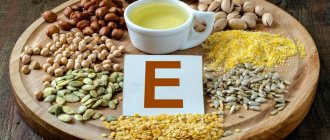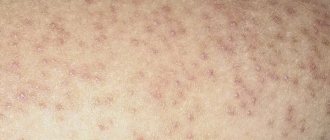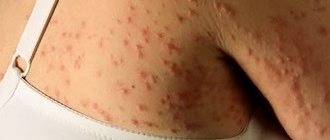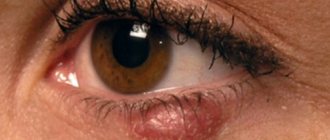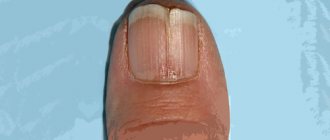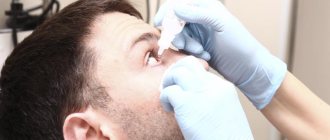How to understand that your facial skin is dry: main signs
Of all skin types, dry skin is perhaps the most insidious. In youth, it causes so few problems that it seems there is no need for a beauty routine! However, insufficient or improper care can lead to increased dryness and the appearance of early wrinkles. What to do? First of all, collect “evidence” that will indicate that you really have dry facial skin.
Main signs of dry facial skin:
- No greasy shine.
- Unpleasant feeling of tightness after washing.
- Tendency to peeling.
- Early wrinkles.
Review of products for dry skin from La Roche-Posay
Micellar gel for face and eyelids Rosaliac Gel
ROSALIAC GEL
Micellar gel
Provides instant hydration, effectively removes makeup and gently cleanses sensitive skin.
RUB 1,935 more details
Moisturizing emulsion for skin prone to redness Rosaliac UV Legere
ROSALIAC UV LEGERE
Moisturizing emulsion
Moisturizes and softens the skin, strengthens the walls of blood vessels and soothes reactive skin of normal and combination types.
RUB 1,846 more details
Intensive moisturizer for dehydrated skin Hydraphase Intense Riche
HYDRAPHASE INTENSE RICHE
Moisturizer
The formula based on hyaluronic acid and glycerin of plant origin, vitamin E and shea butter intensely moisturizes, instantly eliminates the feeling of tightness and discomfort, and smoothes out dehydration creases.
RUB 1,933 more details
Intensive soothing care Toleriane Ultra
TOLERIANE ULTRA
Night cream-gel
Relieves tightness and itching, soothing even hypersensitive skin while you sleep.
RUB 1,784 more details
Toleriane Ultra Nuit restorative and soothing night care for the eye area
TOLERIANE ULTRA NUIT
Night soothing care
Intensively moisturizes and soothes the skin, reduces skin sensitivity, restores comfort and tone.
RUB 1,945 more details
Causes of dry facial skin
One of the root causes of dryness is a weak hydrolipidic barrier of dry skin: if it does not retain moisture well in the epidermis, dryness is almost inevitable. The sebaceous glands are largely responsible for what our skin type will be. If they produce too much sebum, the skin becomes oily, and if they are too greedy, it can become dry.
Other causes of dryness:
- Genes . Yes, dry skin (like cellulite) can be inherited.
- Incorrect care . Rule number one - care should be regular, rule number two - you need cosmetics that suit your skin type. It is the wrong choice of cosmetics that most often causes very dry facial skin. What to do? Thoroughly shake up the shelf in the bathroom!
- Adverse effects of environmental factors . Air overdried by air conditioners and central heating is harmful to dry skin! So does hard or very hot tap water.
- Poor nutrition . A balanced diet is not only the energy that will help you turn the world upside down, but also beautiful skin. She needs vitamins and minerals, so include fresh fish, vegetables, fruits, cereals and, of course, water on your shopping list.
- Ultraviolet radiation . Sun rays dry out the skin and provoke photoaging, which is expressed in loss of elasticity, dull complexion and early wrinkles and/or age spots.
- Age . With age, dry skin becomes more vulnerable.
What happens inside the skin
Information for specialists
The appearance of sagging skin is associated with disturbances in the structure of the dermal layer of the skin:
- Changes in the structure and functioning of fibroblasts - they become more rigid and flat, their synthetic activity decreases, which leads to a decrease in the viscoelastic properties of collagen.
- An insufficient amount of collagen and a violation of its structure leads to impaired contact between fibers and fibroblasts, which for normal functioning must be in a stretched, spindle-shaped state.
- This is how a “vicious circle” arises : lack of collagen synthesis <=> dysfunction of fibroblasts.
Such changes most affect the fibroblasts of the papillary dermis, which primarily affects the normal structure of the papilla of the epidermal-dermal junction.
There is a smoothing of the papillae, which manifests itself in the initial stages as sagging skin. There is a feeling of insufficient tension and elasticity, subsequently ptosis and wrinkles form .
Caring for dry skin at home
Remember the iconic phrase that ignorance of the laws is no excuse? In the case of dry skin, it is 100% correct! Your task is to provide her with the right care, which will reduce dry skin and help get rid of the feeling of tightness.
Daily beauty routine
A day in the life of dry skin looks like this:
MORNING
- Delicate products are suitable for cleansing - for example, gel or foam with caring ingredients.
- Toning is an important step, skipping which can be considered a real beauty crime!
- It’s good if your daily moisturizer contains two types of components: actual moisturizers and moisture retainers.
- Don't forget about caring for the skin around your eyes. In this area, the skin is thinner and more delicate, so additional care and moisturizing is indispensable.
EVENING
- Let's return to where we started - to cleansing! Milk, micellar water or any other product designed for dry skin are suitable for removing makeup, and delicate cleansers are suitable for washing.
- Tonic will help remove remaining impurities and prepare the skin for the next stage of care.
- In addition to the restorative cream for night care, you can apply a complex of oils and serum.
EXTRA CARE
- For exfoliation, it is better to use delicate products with fruit acids. They will have a gentle exfoliating effect.
- Pamper your skin with masks two to three times a week. Very good fabric ones!
Skin xerosis. Part 2: treatment
Dry skin is a constant symptom of various skin diseases, such as atopic dermatitis, psoriasis, eczema, etc. It has now been proven that the constant use of combined moisturizing and lipid-restoring skin products is an essential component in the treatment of many dermatoses [1]. Restoring the damaged epidermal barrier becomes a priority for dry skin. The higher the skin's permeability to water, the deeper the surfactants (surfactants) of detergents, microbes and toxins penetrate into it, causing an inflammatory reaction and the formation of free radicals in the skin. Dry skin is cyclical in nature with an age-related tendency to worsen the condition, so rational cosmetic care adapted to the physiology and structure of the skin is very important. Moisturizers reduce the subjective feeling of tightness, dryness, discomfort, increase the elasticity and tolerance of the skin, even out the microrelief and color of the skin, and strengthen the water-lipid mantle.
The increase in the number of moisturizers with different mechanisms of action occurs in parallel with increasing knowledge about the physiology of the stratum corneum. The study of the epidermal barrier (primarily the lipid matrix) led to the creation of a new therapeutic direction in dermatology - “corneotherapy”. “Corneotherapy” - “treatment of the stratum corneum” (from Latin corneum - horny and English therapy - treatment). It was proposed by the famous American dermatologist Albert Kligman, who has the honor of discovering the role of retinoids in the treatment of acne. A. Kligman became a pioneer in research into the physiology of the outer skin, which led to the development of the concept of the “living stratum corneum”.
You can eliminate dryness of the stratum corneum in various ways:
1) creation of an occlusion on the skin surface that prevents transepidermal water loss (TEWL); 2) use of replacement therapy; 3) use of emollients; 4) creation of osmotic humidification; 5) restoration of the epidermal barrier; 6) use of hygroscopic agents; 7) activation of aquaporin synthesis.
Creation of an occlusion on the skin surface that prevents transepidermal moisture loss. Probably the oldest method of moisturizing is the use of substances that create a waterproof film on the surface of the skin that prevents evaporation. In this way, a compress effect (occlusive dressing) is achieved, which restores and improves the diffusion of fluid from the capillaries of the dermis into the epidermis. Moisturizers with an occlusive effect are used mainly in dermatology, in the treatment of diseases accompanied by increased skin dryness and inflammatory processes, in cosmetology after plastic surgery, such as skin resurfacing, and also to protect the skin during frequent contact with detergents. It is important to remember that this method can be used when the properties of intercellular lipids are undisturbed. This method allows you to capture and redistribute moisture throughout the entire thickness of the epithelium. Although, according to Koshevenko Yu. N. (2008), such occlusion leads not only to a slowdown in the restoration of the barrier function of the epidermis, but also to a disruption in the secretion of lamellar bodies [2].
Occlusive type humidifiers include:
1) fatty acids (lanolin, stearic, etc.); 2) fatty alcohols (lanolin, palmitic, caprylic, etc.); 3) hydrocarbon oils and waxes (vaseline, paraffin, mineral oils, squalene); 4) phospholipids; 5) waxes of plant and animal origin (carnauba wax, lanolin); 6) solid vegetable oils (cocoa, shea, coconut, macadamia, etc.).
Traditionally, in dermatology, for dry, non-oily skin, lipophilic creams of the “water in oil” type are used; such creams are difficult to wash off and, due to the occlusive effect, do not allow the skin to lose moisture and protect against overdrying [3].
Vaseline is the most reliable and proven occlusive coating in dermatology. It is used in products intended to moisturize the skin for psoriasis, atopic dermatitis, etc., as it retains moisture in the skin very well. On the one hand, Vaseline creates a physical barrier to evaporating moisture, on the other hand, it “glues” the horny scales together, resulting in a decrease in the area of contact between the intercellular spaces and the air, which inhibits the process of transepidermal water evaporation. A gel containing 5% petroleum jelly reduces TEWL by 98%. However, moisturizing the skin with Vaseline can be regarded as passive, since it only helps to retain the moisture that is already in the stratum corneum. Another option for hydration - active - is that hygroscopic substances that are capable of binding and retaining water through ionic interactions are introduced into the stratum corneum [4].
Vaseline is currently practically not used in cosmetology, since it is subjectively uncomfortable to use: it is poorly absorbed, shiny, and leaves a feeling of a sticky film. Some cosmetologists recommend Vaseline-based creams to protect the skin during the winter. However, studies have shown that petroleum jelly creates a deceptive sensation of warmth and thereby increases the likelihood of frostbite [5, 6].
Moisturizers intended for the winter period often include saturated fats (goose, badger, bear). Cosmetics containing saturated fats soften the skin well, protect it from frostbite and drying out, but it is not recommended to use it constantly [5].
It should be added that at low temperatures, moisture evaporates from the surface of the skin very quickly, so the prevailing opinion that there is no need to use moisturizers in winter is nothing more than a misconception. It is important to choose them correctly. Winter products should not form too dense an occlusive film and disrupt tissue respiration processes. Such preparations usually include shea butter, jojoba, and macadamia oil, which are quickly absorbed by the skin and create a thin, mobile film without disturbing natural processes. In the winter season, you should be wary of products containing hyaluronic acid and urea, which excellently retain moisture, but in the cold they turn into a crust, resulting in damage to skin vessels.
Recently, silicone occlusive coatings (for example, dimethicone) have become popular, which are widely used in plastic surgery after laser resurfacing, dermabrasion, and other operations. Silicone film, like Vaseline, retains moisture in the skin, preventing stress caused by disruption of the epidermal barrier [5, 7–9].
Occlusive moisturizing creams quickly eliminate dry skin, reduce inflammation and itching in skin diseases, however, they do not eliminate the causes of skin dehydration and can cause local tissue swelling, so they are not suitable for everyone. Thus, if the process of normal restoration of the barrier structures of the stratum corneum is disrupted, for example, in certain skin diseases, occlusive creams are necessary. If there is a chance of restoring the stratum corneum barrier, they should be used only in emergency cases. They are contraindicated for people with healthy skin, as they can disrupt the barrier properties of the epidermis [2].
Replacement therapy. In order to increase the moisture content of the stratum corneum, the same substances that are part of the natural moisturizing factor are added to cosmetics. These are urea, amino acids (serine, glycine, alanine, proline), minerals (magnesium, potassium, sodium, calcium), sodium pyrroglutamate (Na-PCA), lactic acid. Penetrating into the thickness of the stratum corneum, they are localized around corneocytes and create a kind of aqueous membrane [10]. Such humidification has a delayed but prolonged effect and is least dependent on air humidity. The result lasts until the moisturizing components are removed along with the horny scales [5, 8, 10].
Urea is introduced into cosmetic formulations in a concentration of about 5%. Not recommended for use in cosmetics for sensitive skin and children's cosmetics. Has moisturizing, exfoliating and antimicrobial effects. When a person sweats, part of the sweat evaporates, and urea remains on the surface of the skin, adsorbs moisture from the air and retains it in the stratum corneum. It is capable of destroying hydrogen bonds of protein chains, changing the configuration and state of aggregation, promoting the binding of water to the surface of the protein. The small urea molecule penetrates well into the skin, so it can simultaneously serve as a conductor for other active ingredients included in the cosmetic product [5, 6, 9].
Lactic acid. According to research, lactic acid and its salts (lactates) act not only as a hygroscopic agent, but also enhance the synthesis of ceramides by keratinocytes. The L-isomer of lactic acid exhibits the greatest activity and significantly (up to 48%) increases the content of ceramides in the stratum corneum. The introduction of lactic acid into the stratum corneum significantly increases its elasticity, eliminates the symptoms of xerosis and reduces the degree of TEWL. Thus, lactic acid has a moisturizing, exfoliating, and antimicrobial effect [5, 6, 8, 10].
Sodium pyrroglutamate (Na-PCA) is formed in cells during the process of keratinization from the filaggrin protein, and is used in cosmetics as a moisturizing ingredient. The best results are obtained by introducing Na-PCA into liposomes [6, 10].
Amino acids . Of the amino acids that make up NMF, serine, lysine, valine, and citrulline are used in cosmetology. As a rule, not pure amino acids are added to cosmetic preparations, but protein hydrolysates (for example, soy, silk, milk proteins). When sericin (silk protein) is applied in the form of a hydrogel on the skin surface, deep and prolonged hydration of the skin, restoration of the amino acid component NMF, and smoothing of the skin microrelief are observed [5, 8].
Procedures using silk protein involve the application and dissolution of silkworm cocoon fibers directly onto the skin and the absorption of this hydrolyzate by the skin. The chemical name for these fibers is fibroin, a fibrillar protein with a molecular weight of 55,000–100,000 daltons. In their natural state, fibroin fibers are interconnected by the so-called “silk rubber” (sericin protein). In order to keep the fibroin fibers in a dry state, scientists were able to separate the protein bodies from each other and then reunite them during the procedure. Some of the peptides and amino acids gradually penetrate into the stratum corneum, retaining moisture in it for a long time [6].
Emollients . To give the finished product optimal sensory characteristics and regulate occlusive properties, ester emollients are added to moisturizers. Based on polyunsaturated fatty acids (vegetable oils), emollient moisturizers are created that fill the space between exfoliating stratum corneum, replace defects in the stratum corneum formed as a result of excessive desquamation of corneocytes, and replenish the lack of surface lipids. Emollients allow you to adjust the degree of occlusion and provide a quick and prolonged softening effect. Animal studies indicate that this type of moisturizer can cause comedones. Thus, the use of occlusive-type moisturizers is justified in cases where it is necessary to urgently block the transepidermal loss of moisture from the skin and maintain the level of hydration necessary for the normal functioning of cells. Such properties are possessed by a series of post-peeling skin care products and hand products that experience daily attacks from surfactants in detergents and destroy the lipid barrier [8, 10, 11].
Osmotic hydration is achieved by increasing the concentration of osmotically active ingredients. As is known, the hydrobalance of the skin is normalized by the mineral substances that make up the thermal waters. Currently, they are used mainly in the form of aerosols. Vaporized onto the stratum corneum, they increase its osmotic pressure. At the same time, water from the underlying layers enters the stratum corneum and is retained in it, normalizing the concentration of salts and restoring the natural water balance. As a result, the water content increases [10].
Restoration of the epidermal barrier . To restore the epidermal barrier, lipids are used both in the form of pure oils and in combination with other ingredients. It has been proven that local application of lipids (ceramides, phospholipids, triglycerides) accelerates the restoration of the lipid barrier of the skin, with the optimal ratio of ceramides, fatty acids and cholesterol being 1:1:1–3:1:1. The process of restoring the epidermal barrier is a long process and occurs only after the epidermal cells receive the necessary building material and produce a sufficient amount of ceramides and other epidermal lipids from which the epidermal layers will be built [6].
In the 90s, the sympathies of cosmetics manufacturers turned away from the use of natural oils, since silicones came into cosmetic production (in the list of ingredients they can be distinguished by the ending “con”, for example, simethicone, cyclodimethicone, etc.), synthetic derivatives of fatty acids ( they usually have complex names, such as isopropyl myristate, etc.) and other achievements of cosmetic chemistry. With these substances, it became possible to create cosmetics with precisely specified characteristics, which is very difficult with natural oils. However, it was later found that the skin can extract the fatty acids it needs from fats and oils and use them to synthesize its own epidermal lipids, prostaglandins and other regulators of local immunity. Fatty acids enter the skin, as a rule, with natural oils containing essential fatty acids (linoleic, linolenic, arachidonic, as well as their derivatives - gamma-linolenic, arachidonic and some others). More often in cosmetics, olive, soybean, corn oils or oils of black currant, borage, borage, and evening primrose are used [6].
Since these oils are easily oxidized, antioxidants are added to them - vitamin E, carotenoids. It is useful to use oils that themselves have an antioxidant effect - avocado oil, shea butter, grape seed oil, wheat germ oil, rice bran oil. Oils with a high content of unsaponifiable fraction (linseed, soybean, shea, wheat germ) additionally have a phytoestrogenic effect and high anti-inflammatory properties.
But you should always remember the downside of cosmeceuticals based on oils and fats. For example, triglycerides create occlusion and disrupt regeneration processes, preventing the natural moisturizing factor from working, i.e., receiving moisture from the air. Mineral oils also cause occlusion; among other things, they increase the skin’s sensitivity to ultraviolet radiation, which can lead to photosensitivity and hyperpigmentation, so in the summer you should not be overzealous with preparations with a high content of triglycerides and mineral oils.
Ceramides have recently become very popular ingredients in cosmetics. The popularity of ceramides is due to the role they play in maintaining the integrity of the epidermal barrier. Due to the presence of a multilayer lipid layer between the horny scales, the stratum corneum is able to effectively protect the skin not only from the penetration of foreign substances from the outside, but also from dehydration.
To transport hydrophilic active substances into the epidermis, transdermal carriers are often used - complexes of hydrophobic molecules surrounding the active components. The most popular transdermal carriers are liposomes—capsules built from ceramides or phospholipids. The liposome wall consists of a lipid bilayer, and the internal hydrophobic space contains biologically active substances.
Liposomal preparations based on ceramides have a good cosmetic effect, but they are quite expensive and difficult to produce due to the low solubility of ceramides in water. Recently, emulsions based on saturated phospholipids (they are similar to ceramides, but have two hydrophobic tails) have become increasingly popular. These can be liposomes or flat membrane-like structures (lamellae). Such phospholipids form crystal structures similar to the structure of the lipid layers of the stratum corneum. When exposed to a damaged stratum corneum, liposomes or lipid lamellae are embedded in areas deprived of lipids, thereby temporarily restoring the epidermal barrier [2, 6, 10].
Fundamental research in the field of cytology, biochemistry and biophysics of the skin has led to the emergence of a new drug that maintains water balance in the skin - the dermal membrane structure (DMS®) of the cream imitates the natural structure of the arrangement of epidermal lipids. DMS has a lamellar structure and undetectable particle sizes, in contrast to the drop-shaped structures of traditional creams. It is this technology that is used to create Physiogel cream, which has a full set of lipids identical to the lipids of the epidermis. A feature of this cream that distinguishes it from other creams is a special substance - hydrogenated phosphatidylcholine (HPC). As is known, natural phosphatidylcholine is a key component of keratinocyte cell membranes. In the stratum corneum it serves as a source for sphingomyelin and ceramides. Hydrogenated phosphatidylcholine, which is part of Physiogel, is essentially a skeleton on which the lipids of the cream are fixed, creating a natural self-emulsifying system. This system provides the cream with a number of properties:
- there is no ability to form emulsions in the form of “water in fat” or “fat in water”;
- forms the lamellar structure of DMS (lamellar structures consisting of bilipid layers that retain physiological lipids);
- able to penetrate deep into the stratum corneum of the epidermis;
- enhances skin barrier properties and photoprotection.
The use of “self-emulsifying” systems based on phosphatidylcholine minimizes the risk of irritation and justifies its use for the treatment of chronic dermatoses. DMS ensures the “correct” penetration of lipids - it is embedded in the stratum corneum, but does not penetrate deeper.
Scientific studies conducted using instrumental research methods (electron micrographs and determination of corneometry) have established that by the 14th day of comparative testing of various creams, Physiogel has indicators that are not inferior to other creams in terms of the degree of skin hydration. But by the 28th day, the moisture content increases 4 times and is far ahead of other creams. These studies prove that Physiogel cream does not provide passive hydration, but active one, restoring the natural water-saving structure of the epidermis.
It should be remembered that the process of skin restoration occurs slowly. Therefore, the effect of using Vaseline, emollients and moisturizers will be more noticeable than the effect of using creams containing essential fatty acids. Since polyunsaturated fatty acids cannot be an emergency treatment for barrier breakdown, they must be taken regularly to prevent the occurrence of deficiency conditions.
Moisturizing the skin with hygroscopic agents. For normal skin without gross pathologies, non-occlusive moisturizers are used. Usually these are gels containing hygroscopic substances (proteins, polysaccharides, glycosaminoglycans).
Glycerin is an effective humectant under normal atmospheric humidity conditions. Glycerin is hygroscopic, but has high volatility, which negatively affects the duration of the moisturizing effect. Glycerin does not have the ability to penetrate deep into the stratum corneum, so its effect is superficial. But it softens the skin, lowers the freezing point of liquid (prevents the cream from freezing on the face on a frosty day), and in humid air it works as a skin moisturizer, attracting moisture from the atmosphere. However, in dry air it has the opposite effect - it draws water from the stratum corneum, so upon short-term contact with the skin it has a moisturizing effect, but then, on the contrary, it aggravates the dryness of the skin, drawing moisture from it. For example, sorbitol is less hygroscopic than glycerin, so there is less risk of skin drying [4].
Propylene glycol is used as a solvent in cosmetic formulations (replaces water). Non-toxic, softens the skin, reduces the freezing point of liquids, and has an antimicrobial effect. It is highly hygroscopic, however, like glycerin, in a dry atmosphere it can draw water from the stratum corneum [4].
Hyaluronic acid (HA) is a glycosaminoglycan, which is the main component of the intercellular matrix of living tissues. Until recently, HA was spoken of as the main substance of the intercellular substance of the dermis. However, recent studies indicate that HA performs essential functions in the epithelial layer of the skin and enters the epidermis not from the dermis, but is synthesized by the corneocytes themselves [12, 13]. In this case, the synthesis of molecules with a very large molecular weight occurs - about 2 million kDa, and the catabolism of HA also occurs in the lysosomes of keratinocytes. This natural polysaccharide takes an active part in the proliferation, differentiation and migration of keratinocytes, therefore its amount is under the control of various regulatory molecules and is maintained at a level of 0.1 mg/kg.
HA is a very popular ingredient in skin care products. Cosmetic preparations with HA have a pronounced moisturizing effect due to the formation of a thin film on the surface of the skin, which helps reduce TEWL, which actively absorbs moisture from the air. This helps to increase the free water content in the stratum corneum, and also creates an “additional moisture” effect, which helps reduce the evaporation of water from the surface of the skin. As is known, HA is able to penetrate into the deep layers of the skin and transport substances associated with it or enclosed in its mesh structure.
Soluble collagen, due to its hygroscopic properties, forms a moisturizing film on the skin, thus reducing water loss through the stratum corneum.
Chitosan is a polysaccharide obtained from the shells of marine crustaceans. Forms a moisturizing film on the skin, softens the skin and protects it from damage.
Beta-glucan is a polysaccharide obtained from the cell wall of baker's yeast. Forms a moisturizing film on the skin, protects the skin from UV radiation, and has an immunostimulating effect.
Activation of aquaporin synthesis. As stated in the first part of the article, transmembrane proteins aquaporins play an important role in maintaining normal levels of skin hydration. The human epidermis contains the main skin aquaporin, aquaporin-3 (AQP-3), located on the keratinocyte membrane.
In skin pathologies characterized by impaired barrier function and dry skin, changes in the expression of aquaporins are observed. An interesting fact is that the expression of AQP-3 decreases in direct proportion to the degree of exudation in eczema, while at the same time its increased expression is noted in atopic dermatitis [14–16].
When the AQP-3 content decreases, the hydration of the epidermis and the barrier function of the skin are disrupted, and its elasticity decreases. In addition, it has been proven that with age, the amount of AQP-3 in the epidermis decreases, which is the main reason for the decrease in hydration levels of aging skin. Currently, an active search is underway for compounds that stimulate the synthesis of aquaporins. Modulation of their expression is one of the promising ways to moisturize the skin [14–16].
In conclusion, it must be emphasized that we are talking not only about auxiliary therapy of cosmeceuticals during an exacerbation, but also about a very important issue - securing remission by actively restoring the integrity of the skin and its normal function with the help of therapeutic and cosmetic products. Today, a doctor’s arsenal includes a sufficient number of moisturizing and softening therapeutic and cosmetic products specially created for caring for the skin of patients, and the ability to navigate them is the key to the success of therapy.
Literature
- Lomakina E. A. The role of the barrier function of the skin in the pathogenesis of some dermatoses // Modern problems of dermatovenereology, immunology and medical cosmetology. 2009, no. 2. pp. 87–90.
- Koshevenko Yu. N. Human skin. T. 2. M.: Medicine, 2008. 754 p.
- Lulman H. Visual pharmacology. M.: Mir, 2008. 383 p.
- Hernandez E. Polyhydroxy acids against ichthyosis // Peelings. 2010, no. 1. pp. 18–22.
- Timofeev G. A. Methods of hardware research of human skin // Cosmetics and medicine. 2005; 4:30–36.
- Margolina A. A., Hernandez E. I., Zaikina O. E. New cosmetology. M., 2002. 208 p.
- Modern external therapy of dermatoses (with elements of physiotherapy) / Under. edited by N. G. Korotky. Tver: “Provincial Medicine”, 2001. 528 p.
- Puchkova T.V. Explanatory dictionary of cosmetics and perfumery. M.: School of cosmetic chemists, 2005. 192 p.
- Ivanova L., Podolyak S. Active moisturizing components in cosmetics // Journal of applied aesthetics Les Nouvelles Esthetique. 2008, no. 3. pp. 125–132.
- Hernandez E.I. Skin hydration. M.: LLC "Firm Clavel", LLC "School of Cosmetic Chemists", 2007. 32 p.
- Timofeev G. A. Dry skin. Functional diagnostics. Tactics // Cosmetics and medicine. 2007, no. 2. pp. 58–62.
- Koshevenko Yu. N. Human skin. T. 1. M.: Medicine, 2006, 360 p.
- Myadlets O. D., Adaskevich V. P. Morphofunctional dermatology. M.: Medlit, 2006. 752 p.
- Tkachenko S., Hernandez E. Aquaporins in the regulation of skin water balance // Cosmetics and medicine. 2011, no. 2. pp. 26–33.
- Cork MJ, Robinson DA, Vasilopoulos Y. et al. New perspectives on epidermal barrier dysfunction in atopic dermatitis: gene-environment interactions // J Allergy Clin Immunol. 2006; 118(1):3–21.
- Wilkinson JD The skin as a chemical barrier. In: The Physical Nature of the Skin. Marks RM, Barton SP, Edwards C. eds. MPT Press, 1988: 73–78.
Yu. A. Gallyamova, Doctor of Medical Sciences, Professor O. A. Barinova
GOU DPO RMAPO, Moscow
Contact information for authors for correspondence
Seasonal care features
- In summer (and not only!), sun protection is important for dry skin. Depending on your phototype, choose UV protection products.
- In autumn, it is important to prepare your skin for the cold: put all your efforts into restoring the barrier function!
- In winter, cold wind and frost have an extremely adverse effect on the skin. Try using denser and thicker textures with a rich nutritional formula and protective function. It is better to apply water-based skincare products some time before going outside so that they are well absorbed.
- In spring, you can switch to products with a lighter texture and moisturizers with UV filters.
What diseases cause itching and flaking of the skin?
There are quite a few diseases accompanied by itching and peeling of the skin of varying degrees of intensity and prevalence:
- allergies to food, medications;
- contact dermatitis;
- seborrhea;
- psoriasis;
- eczema;
- fungal skin diseases;
- disruption of the sebaceous glands;
- infectious diseases;
- diabetes;
- hormonal disorders;
- thyroid diseases;
- blood diseases;
- parasitic diseases (scabies, demodicosis, etc.).
Clinical researches
The effectiveness, safety and tolerability of La-Cri products have been clinically proven. The products are recommended by the Union of Pediatricians of Russia. During clinical studies, specialists were able to record excellent results. It has been empirically proven that La Cree emulsion moisturizes and nourishes the skin, relieves itching and irritation.
Sources:
- Chapman M. Shane, Habiff Thomas P., Zug Catherine A., Dinoulos James G. H., Campbell James L., Dermatology. Handbook of differential diagnosis, MEDpress-inform, 2014.
- Sukolin Gennady Ivanovich, Illustrated clinical dermatology. Brief alphabetical reference book, Lux Print publishing house, 2010.
- Sukolin Gennady Ivanovich, Clinical dermatology. A short guide to the diagnosis and treatment of dermatoses, Notabene, 2017.
